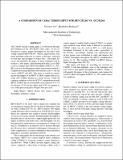A comparison of CABAC throughput for HEVC/H.265 VS. AVC/H.264
Author(s)
Sze, Vivienne; Budagavi, Madhukar
Downloadsze CABAC_SIPS_2013.pdf (233.0Kb)
OPEN_ACCESS_POLICY
Open Access Policy
Creative Commons Attribution-Noncommercial-Share Alike
Terms of use
Metadata
Show full item recordAbstract
The CABAC entropy coding engine is a well known throughput bottleneck in the AVC/H.264 video codec. It was redesigned to achieve higher throughput for the latest video coding standard HEVC/H.265. Various improvements were made including reduction in context coded bins, reduction in total bins and grouping of bypass bins. This paper discusses and quantifies the impact of these techniques and introduces a new metric called Bjontegaard delta cycles (BD-cycle) to compare the CABAC throughput of HEVC vs. AVC. BD-cycle uses the Bjontegaard delta measurement method to compute the average difference between the cycles vs. bit-rate curves of HEVC and AVC. This metric is useful for estimating the throughput of an HEVC CABAC engine from an existing AVC CABAC design for a given bit-rate. Under the common conditions set by the JCT-VC standardization body, HEVC CABAC has an average BD-cycle reduction of 31.1% for all intra, 24.3% for low delay, and 25.9% for random ac-cess, when processing up to 8 bypass bins per cycle.
Date issued
2013-10Department
Massachusetts Institute of Technology. Department of Electrical Engineering and Computer ScienceJournal
2013 IEEE Workshops on Signal Processing Systems (SiPS)
Publisher
Institute of Electrical and Electronics Engineers (IEEE)
Citation
Sze, Vivienne, and Madhukar Budagavi. “A Comparison of CABAC Throughput for HEVC/H.265 VS. AVC/H.264.” SiPS 2013 Proceedings (October 2013).
Version: Author's final manuscript
ISBN
978-1-4673-6238-2
ISSN
2162-3562